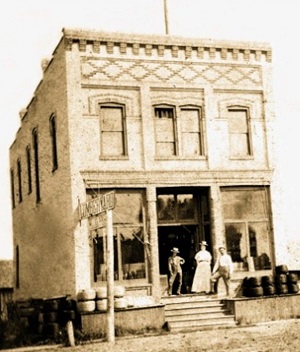A BRIEF HISTORY OF THE MILLER-PIEHL BUILDING AND COMPANY
 A Brief History of the Miller-Piehl Company and Building
A Brief History of the Miller-Piehl Company and Building
The building was built by Fred Piehl in 1893-94. He was the grandfather of Frank Piehl, the last owner. Fred Piehl, came to Seymour from Germany via Canada. He was aboard the emigrant ship, “The Leibnitz."
Earliest ledger records show 1885 as a beginning year of the business. Fred Piehl and William Miller came to Wisconsin because of a growing interest in farming and immigrant settlement. They had known each other in Canada where Fred was a farm hand for William's father. They saw a lucrative market for cedar posts and a growing need for lumber and building supplies and decided to make Seymour the center of their business. Miller invested in the company until the late 1940s, although he was never active in the local end of the business operation.
The original company and sawmill were located where Don’s Quality Market now stands. Sparks from the steam plant ignited a fire in the sawmill, burning it to the ground in the late 1890s. The company rebuilt at the present location north of the railroad tracks on Depot Street.
In the beginning all the office work was done by family members including Fred's daughters who were sent to business school in Green Bay. The oldest of Fred's sons was sent to Oneida County to run the logging part of the company. William Miller had an office in the lumber Exchange in Minneapolis and served as a agent for the timber operation. All members of the Fred Piehl family were involved in some capacity. William was the company manager and salesman. Miller-Piehl also had yards operating in Oneida and Navarino.
With up to eight trains a day passing through the city, Depot Street was the center of activity during the first half of the 20th Century. A coal shed continued to be located on the former location until about 1925 and a cement shed was located across the tracks, southwest of the depot until 1925-26. Frank Piehl remembered the employee, Bill Hilgenberg, who to fill a cement order for a waiting customer, would put one sack on his shoulders others under each arm and walk across the tracks to the waiting wagon.
Fred Piehl who along with other varied talents was a brick mason designed and directed the work force. The windows are typical of the era of the 1890s. Fred Piehl also built several other houses and buildings in Seymour and was active in the management of the yard.
The brick used for the building came from the Duck Creek Brick Yards and was transported to Seymour by way of box cars. Typical brick from this yard have a flying duck design depressed in each brick.
Some changes have been made in the building since Fred Piehl's time. Two additions, one for office space and another for storage, were added in the early years. The original building had an upstairs reached by an outside stairway on the west side wall. The upstairs room was used by as a meeting space by lodge organizations and religious groups. In later years Dr. Carlisle Runge, Fred's son-in-law, had a dental office in the south side of the second floor.
The original front door was in the middle of the building. This change was made in 1927 or 1928. The large safe in the present building marks the north wall of the original building where the stairs are now located. In the 1920’s a hand operated elevator was installed to get supplies from the second floor, now used for storage.
The pre-1960 office building had desks, railings, a glass enclosed manager’s office and high bookkeeping desks and stools placed along the east side of the room. In the back of the first floor room stood barrels of red and yellow linseed oil, turpentine, Japan dryer, Dutch white lead, plus a container for nails. This was the messiest part of the operation. The rest of the room was taken up with other paint supplies, staples of barbed wire, stair samples, screens and other building materials.
Behind the original buildings a few yards away stood a small lime shed. Like the sawmill this too burned down. This occurred during the first flood of the Little Henry Creek nearby.
Other sheds torn down during the 1980s, were constructed from 1905 to the 1920s and used for storing windows, doors, cement and a variety of building materials needed as demands changed in the building industry.
The building served the construction interests of the community and now continues to serve as a vital facility to help preserve area history. The following page contains a number of pictures illustrating how the building depicts a 1930s general store similar to those in Seymour, Isaar, Briarton, Roselawn and Brasses' Corners.